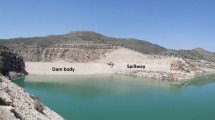Abstract
The paper presents the case of the Boljunčica reservoir, which began operation in 1973. It is situated on the Istria peninsula (Croatia). This is a multipurpose reservoir which was built in order to protect the downstream area from flood, to store water for irrigation, and to control sediment transport. The reservoir is situated on the contact zone between water impermeable Eocene flysch and deep Eocene and Cretaceous limestone. The bottom of the reservoir is covered partly by both flysch and quaternary deposits. Water losses from the reservoir bottom are so large that the main service intended for the reservoir, the storage of water for irrigation, is impossible. After every intensive precipitation, which occurs often in this region, the reservoir fills very quickly. The problem is that its retention of water is very short, and lasts only a few days. The water volume of the reservoir at the spillway altitude of 93.00 m a. s. l. is about 6.5 × 106 m3. Because of water losses from the reservoir bottom, the mean annual volume of water stored in it, during the period of 1977–2005 was only 0.5 × 106 m3, which is less than 8% of the full reservoir volume. On the reservoir bottom, many new swallow holes opened through the sediment cover after each time it filled and emptied with water. Special attention is paid to the groundwater level analyses. Interdisciplinary analyses and investigations of hydrological and hydrogeological factors causing the formation of swallow holes and water losses from the Boljunčica reservoir are discussed. The example given in this paper explains one unsuccessful case of building a reservoir in Dinaric karst, caused mainly due to insufficient geological, hydrogeological and hydrological investigations. In order to prevent water losses from the Boljunčica reservoir, very complex and expensive work needs to be done, but its success regarding the reasonable reduction of water losses from the reservoir is in question.






Similar content being viewed by others
References
Ahmadipour M (2005) The effect of sinkholes on leakage of water from the Sarabchenar dam, Southwest Iran. J Environ Hydrol 13:1–5
Bonacci O, Roje-Bonacci T (2000) Interpretation of groundwater level monitoring results in karst aquifers: examples from the Dinaric karst. Hydrol Proc 14:2423–2438
Bonacci O, Roje-Bonacci T (2008) Water losses from the Ričice reservoir built in the Dinaric karst. Eng Geol 98:121–127
Drogue C (1985) Geothermal gradients and ground water circulation in fissured and Karstic rocks: the role played by the structure of the permeable network. J Geodyn 4:219–231
Dreybrodt W, Romanov D, Gabrovšek F (2002) Karstification below dam sites: a model of increasing leakage from reservoirs. Environ Geol 42(5):518–524
Fazeli MA (2007) Construction of grout curtain in karstic environment: case study Salman Farsi Dam. Environ Geol 51(5):791–796
Ford D, Williams P (2007) Karst hydrogeology and geomorphology. Wiley, Chichester, p 562
Günay G, Milanović P (2007) Karst engineering studies at the Akköprü Reservoir area, southwest of Turkey. Environ Geol 51(5):781–785
Mangin A (1997) Structure et functionement des aquifères karstiques les concepts et les approches. In: Jeannin PY, Sauter M (eds) Proceedings of the 12th international congress of speleology. La Chaux de Fonds, Switzerland, pp 3–9
Milanović PT (2004a) Water resources engineering in karst. CRC Press, Boca Ratom, p 312
Milanović PT (2004b) Dams and reservoirs on karst. In: Gunn J (ed) Encyclopedia of cave and karst science. Fitzroy Dearborn, New York, pp 277–279
Romanov D, Gabrovšek F, Dreybrodt W (2003) Dam sites in soluble rocks: a model of increasing leakage by dissolutional widening of fractures beneath a dam. Eng Geol 70(1–2):17–35
Romanov D, Gabrovšek F, Dreybrodt W (2007) Leakage below dam sites in limestones terrains by enhanced karstification: a modelling approach. Environ Geol 51(5):775–779
Rubinić J (2000) Hydrological aspects of reservoir planning and managing—case of the Boljunčica reservoir in Istria. MSc, University of Split, Croatia [in Croatian]
Turkmen S (2003) Treatment of the seepage problems at the Kelcik dam (Turkey). Eng Geol 68:159–169
Unual B, Eren M, Yalcin MG (2007) Investigating of leakage at Ataturk dam and hydroelectric power plant by means of hydrometric measurements. Eng Geol 93:45–63
Waltham T, Bell F, Culshaw M (2005) Sinkholes and subsidence—karst and cavernous rocks in engineering constructions. Springer, Berlin, p 382
White WB, White EL (1989) Karst hydrology—concepts from the Mammoth cave area. Van Nostrand Reinhold, New York, p 346
Author information
Authors and Affiliations
Corresponding author
Rights and permissions
About this article
Cite this article
Bonacci, O., Rubinić, J. Water losses from a reservoir built in karst: the example of the Boljunčica reservoir (Istria, Croatia). Environ Geol 58, 339–345 (2009). https://doi.org/10.1007/s00254-008-1599-z
Received:
Accepted:
Published:
Issue Date:
DOI: https://doi.org/10.1007/s00254-008-1599-z




